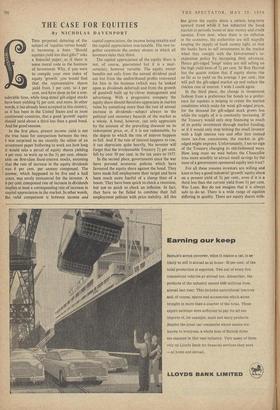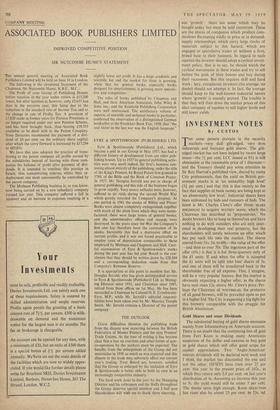THE CASE FOR EQUITIES
By NICHOLAS DAVENPORT And for good reasons. .
In the first place, present income yield is not the true basis for comparison between the two. I was surprised to see recently the editor of an investment paper bothering to work out how long it would take a parcel of equity shares yielding 4 per cent. to work up to the 5/ per cent, obtain- able on first-class fixed-interest stocks, assuming that the rate of increase in the equity dividends was 6 per cent, per annum compound. The answer, which happened to be five and a half years, was surely immaterial for the investor. A 6 per cent, compound rate of increase in dividends implies at least a corresponding rate of increase in capital appreciation in the market. In other words, the valid comparison is between income and
capital appreciation, the income being taxable and the capital appreciation non-taxable. The two to- gether constitute the money stream in which all investors slake their thirst.
The capital appreciation of the equity share is not, of course, guaranteed but it is a near- certainty, however variable. The equity owner benefits not only from the annual dividend paid out but from the undistributed profits reinvested for him in the business (which may be looked upon as dividends deferred) and from the growth of goodwill built up by clever management and advertising. With a progressive company the equity share should therefore appreciate in market value by something more than the rate of annual increase in dividends—subject always to the political and monetary hazards of the market as a whole. A bond, however, can only appreciate by the amount of the prevailing discount on its redemption price, or, if it is not redeemable, by the degree to which the rate of interest happens to fall. And if the rate of interest happens to rise, it can depreciate quite heavily. No investor will forget that the irredeemable Treasury 21 per cent. fell by over 50 per cent, in the ten years to 1957.
In the second place, governments since the war have pursued economic policies which have favoured the equity share against the bond. They have made full employment their target and have been much more fearful of a slump than of a boom. They have been quick to check a recession, but not so quick to check an inflation. In fact, they have so far failed to combine their full employment policies with price stability. All this has given the equity share a certain long-term upward trend while it has subjected the bond market to periodic bouts of dear money and credit squeeze. Even now, when there is no inflation in the economy, the authorities are still stupidly keeping the supply of bank money tight, so that the banks have to sell investments in the market when they comply with the Government's re- expansion policy by increasing their advances. Hence gilt-edged 'longs' today are still selling on the high yield basis of 51 per cent. Sir Roy Harrod has the quaint notion that if equity shares rise so far as to yield on the average 3 per cent., this will pull the gilt-edged market up and reduce the riskless rate of interest. I wish I could agree.
In the third place, the change in investment fashion from a preference for bonds to a prefer- ence for equities is helping to create the market conditions which make for weak gilt-edged prices, for the demand for gilt-edged stock grows less while the supply of it is constantly increasing. If the Treasury would only stop financing so much of its public investment through market funding, or if it would only stop bribing the small investor with a high interest rate and offer him instead more tax-free concessions, the market in gilt- edged might improve. Unfortunately, I see no sign of the Treasury changing its old-fashioned ways. How long must we wait before the Chancellor tries more sensibly to attract small savings by the issue of a government-sponsored equity unit trust?
For all these reasons investors are willing and keen to buy a good industrial 'growth' equity share on a present yield of 3/ per cent., even if it is a third less than the current yield from 3/ per cent. War Loan. But do not imagine that it is always safe to do so. There is a wide range of equities differing in quality. There are equity shares with- out 'growth' : there are some which may be bought today but must be sold tomorrow. These are the shares of companies which produce com- modities fluctuating wildly in price or in demand- supply relationships, which carry large stocks of materials subject to this hazard, which are engaged in speculative trades or without a firm, broad base to their business. In regard to such equities the investor should adopt a cyclical invest- ment policy, that is to say, he should watch the cyclical movements in these trades and try to sell before the peak of their booms and buy during their recessions. But this requires skill and hard work : lazy, complacent investors (the average, no doubt) should not attempt it. In fact, the average should keep to the well-known industrial names where 'growth' is soundly proved. The trouble is that they will then drive the market prices of this elect company of equities to still higher levels and still lower yields.















































 Previous page
Previous page